Bulletin – December 2010 Domestic Market Operations and Liquidity Forecasting
Abstract
The stance of monetary policy in Australia is set in terms of a target for the cash rate. To keep the cash rate at the policy target, the Reserve Bank sets the supply of Exchange Settlement (ES) balances at a level consistent with demand. The level of ES balances changes when entities in the private banking system transact with the Reserve Bank and its clients, particularly the Australian Government. These changes need to be accurately forecast, so that they can be counterbalanced by the Reserve Bank's domestic market operations.
Introduction
The stance of monetary policy in Australia is determined by the Reserve Bank Board and is set in terms of a target for the cash rate – the interest rate on overnight, unsecured loans between financial institutions. The cash rate in turn affects the broad spectrum of interest rates in the financial system and, consequently, economic activity and inflation. This article discusses the way in which the Bank implements monetary policy and maintains the cash rate at target, including: the role of settlement balances as a source of interbank liquidity; forecasting daily flows that alter the level of liquidity; and the use of market operations to smooth and offset these fluctuations to ensure that liquidity remains at an appropriate level.
Liquidity and the Stance of Monetary Policy
The cash rate is determined in the market by the interplay of the demand for, and the supply of, Exchange Settlement (ES) balances. These are funds held on deposit with the Reserve Bank by authorised deposit-taking institutions (ADIs) and are these institutions' most immediate source of liquidity, used to settle transactions between themselves as well as with the Bank or its clients.[1]
In order to keep the cash rate at the target set by the Board, each day the Reserve Bank adjusts the total supply of ES balances – referred to as ‘system cash’ – to a level consistent with the demand for ES balances. Individual institutions must maintain a positive ES balance at all times, and those that face the prospect of a negative balance (because of payments flows through the day, discussed further below) will seek to borrow funds overnight from institutions with excess balances. As such, if there is strong demand for ES balances relative to their overall supply, there will tend to be upward pressure on the cash rate. On the other hand, if demand for ES balances is low relative to their supply, there will tend to be downward pressure on the cash rate.
In practice, short-term movements in system cash do not tend to affect the cash rate. In part, this is due to the anchor provided by a publicly announced target and the very strong commitment by the Reserve Bank to ensure that the cash rate stays at the target rate. Another factor is the structure of the Australian cash market, which has a small number of participants, with relatively high ratings by international standards. As the cash positions of individual institutions vary substantially from day to day, an institution that is lending ES balances one day may well be borrowing the next, providing an incentive to transact at the target cash rate by convention.
When the Reserve Bank announces a change in the stance of monetary policy, the Bank does not adjust the level of system cash – rather, the announcement itself is sufficient to move the actual cash rate. This is because the Bank establishes a ‘corridor’ around the target cash rate, that ensures the incentives for banks to hold ES balances are unaffected by the stance of policy. The lower bound of the corridor is the rate of interest paid on ES balances, set at 25 basis points below the target cash rate, while the upper bound, 25 basis points above the target cash rate, is the rate at which institutions can access the Reserve Bank's standing facility and obtain funds on a secured overnight basis. Because the opportunity cost of holding ES balances is not affected by changes in the cash rate, always being a constant 25 basis points, the banking system's demand for ES balances does not shift due to a change in the cash rate.
As a result of these factors, system cash has tended to be relatively invariant with respect to the stance of policy. This is clearest in the period prior to the financial crisis (Graph 1). Between 2002 and mid 2007, the cash rate varied between 4.25 per cent and 6.25 per cent, but aggregate ES balances were consistently maintained at around $750 million, increasing only temporarily to accommodate spikes in demand around month- and year-end. The financial crisis saw a sharp rise in banks' demand for ES balances, due to an increased desire to hold liquid, risk-free assets. To accommodate this increased precautionary demand the Reserve Bank raised the supply of ES balances, with system cash frequently in the range of $3 billion to $12 billion[2]. As conditions in financial markets have normalised over the past year, the banks' precautionary demand for ES balances has receded and the level of system cash has declined to around $1¼ billion. Throughout this period, and notwithstanding the large swings in demand, the cash rate has remained very close to target. In 2008/09, the cash rate traded at target on every day, while in 2009/10 the cash rate deviated from target on just two days by one basis point.
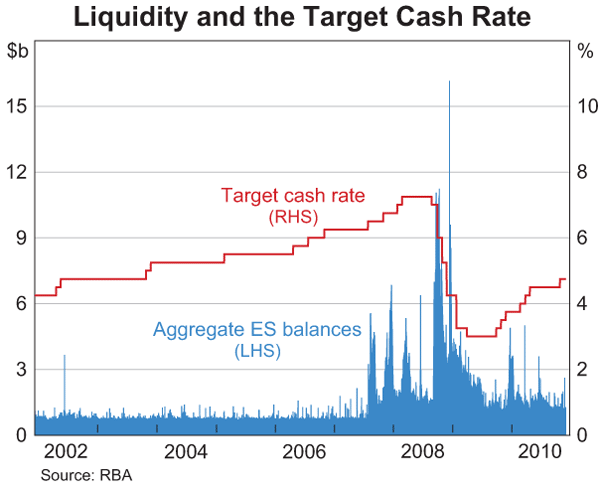
Movements in System Cash
ES balances are used by financial institutions to settle transactions, both with other financial institutions and with the Reserve Bank and its clients. Payments between private financial institutions do not affect the aggregate level of system cash, but rather redistribute ES balances within the financial system. However, when a private institution makes a payment to the Reserve Bank or its clients, this reduces the pool of ES balances (‘withdraws liquidity’), while a payment from the Reserve Bank or its clients to a private institution increases the pool of ES balances (‘injects liquidity’).
Transactions between the Reserve Bank or its clients and the private financial system fall into two groups. First, those initiated by the Bank with the express intent of affecting the level of system cash are known as market operations. Second, those transactions occurring for reasons other than managing liquidity are referred to as exogenous transactions. Exogenous transactions arise for a variety of reasons relating to the various business and policy functions of the Bank. The sources of such transactions can be seen by looking at the central bank's balance sheet (see Appendix A). The most important transactions, as summarised in Figure 1, relate to client transactions, foreign exchange reserves management and currency note issuance.
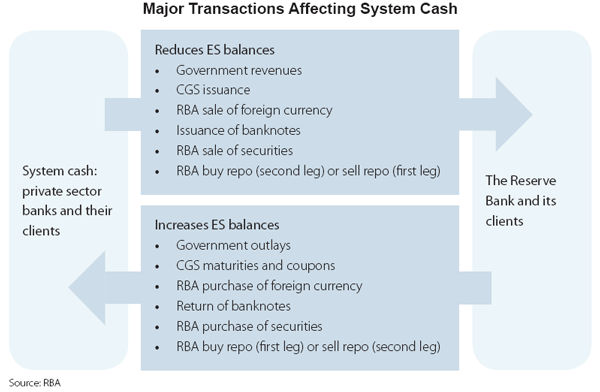
Client transactions
The Reserve Bank provides banking services to various clients, including many Australian Government departments and agencies, foreign central banks and other official institutions. Any transaction between a client of the Reserve Bank and an ES account holder (or, in turn, its client) will affect system cash. The largest and most significant client transactions from a liquidity standpoint are those of the Australian Government's departments and agencies.[3] In particular:
- government revenues, such as tax collections, result in funds flowing from individuals and businesses to accounts at the Reserve Bank, thereby reducing liquidity;
- government outlays, such as social security and welfare payments, result in funds flowing from accounts at the Reserve Bank to private accounts, injecting liquidity; and
- government financing, through the issuance of Commonwealth Government securities (CGS), withdraws liquidity, while maturities and coupon payments inject liquidity.
The net impact of government transactions on system cash each day is known as the Government system cash position (Graph 2). This position can be very large, primarily reflecting the different timing of the Government's outlays, revenues and financing. Outlays tend to be relatively smooth through the year, although they peak twice each month with payments by the Australian Government to the states and territories.[4] On the other hand, revenues are more lumpy, and are clustered around major due dates for GST and corporate tax collections.[5] Financing, particularly through bond issuance, is relatively smooth over time, while maturities can result in large and irregular liquidity injections.
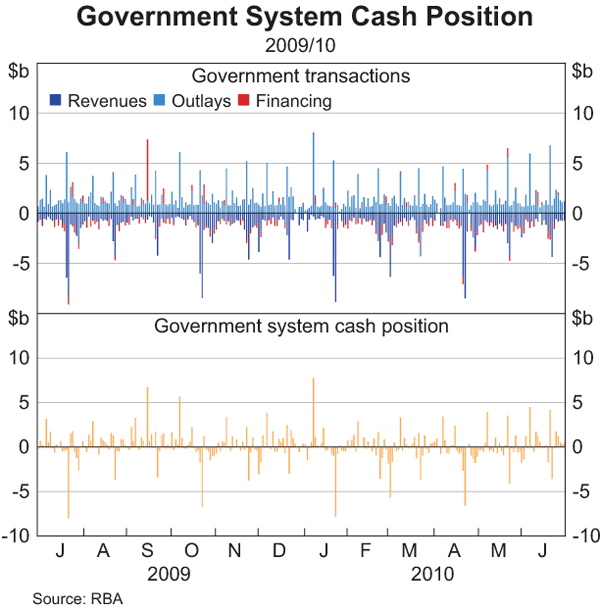
Other exogenous transactions
While transactions by Reserve Bank clients constitute the most significant source of exogenous transactions, there are many other transactions that may occur on a daily basis. Of particular note:
- Since the Reserve Bank manages Australia's foreign exchange reserves, there are regular purchases (sales) of foreign currency against Australian dollars that inject (withdraw) ES balances, which are denominated in Australian dollars.
- Because the Reserve Bank is responsible for issuing Australia's banknotes, when commercial banks purchase banknotes from the Reserve Bank, their ES balances are debited, so that funds are withdrawn from the system, and when notes are returned to the Reserve Bank, ES balances are injected.
Exogenous Flows and Market Operations
The impact of government and other exogenous transactions on system cash can potentially be very large – it is not unusual for these transactions to withdraw or inject $5 billion or more of ES balances in a day. This is generally well in excess of total ES balances, so if left unchecked they would push the cash rate away from the target rate.
As such, to maintain an appropriate level of system cash over time the Reserve Bank must counter-balance exogenous transactions with open market operations. Market operations are conducted primarily through repurchase agreements (‘repos’) with counterparties who are generally ES account holders. Repos involve two legs. First, the Bank buys (sells) a security from (to) a counterparty, injecting (withdrawing) liquidity. Second, at an agreed later date, the initial purchase (sale) is reversed and the liquidity injection (withdrawal) is unwound. Repos offer a number of advantages, including a liquid market, a very high degree of protection from credit risk and a low level of interest rate risk. From time to time, market operations can also include outright securities transactions and foreign exchange swaps.[6]
Together, exogenous liquidity flows and unwinding repos comprise the system cash position (Graph 3). This is the amount by which system cash would change on a day in the absence of new market operations. A system cash deficit would see a fall in ES balances while a system cash surplus would see an increase.
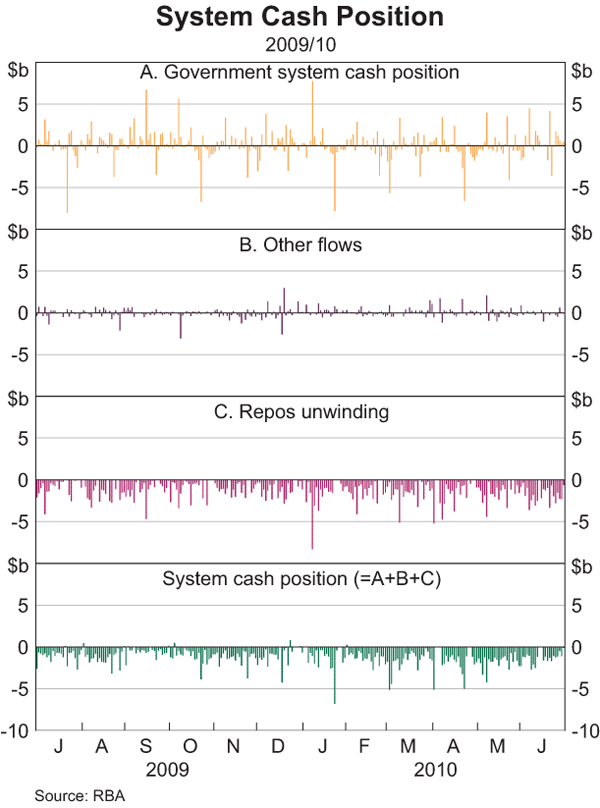
On most days, the Reserve Bank looks to engineer a system cash deficit. This allows for frequent market interaction, which assists in gauging demand for ES balances and risk sentiment more broadly. This was of particular benefit during the financial crisis when, aided by the flexibility of the framework for market operations, the Bank was able to respond quickly and effectively to swings in demand for ES balances. Daily operations also provide a degree of certainty to repo market counterparties, and help smooth the redistribution of funds within the system.
In order to counterbalance a system cash deficit, the first leg of market operations usually involves the Reserve Bank injecting liquidity by buying securities under repo. With demand for ES balances fairly stable on most days, the amount of liquidity injected is generally of a similar size to the system cash deficit (Graph 4). On less frequent occasions, the Bank may also look to withdraw funds through its market operations.
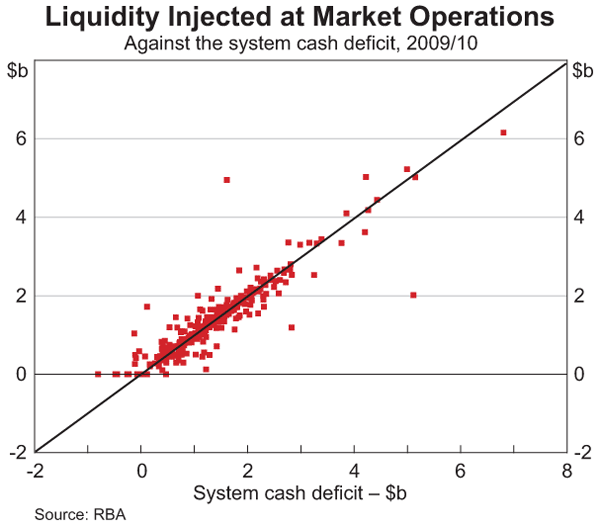
In turn, the second leg of repos tends to withdraw liquidity. In order to smooth expected funds flows, the Reserve Bank aims to have repos unwind on days where exogenous transactions are either injecting liquidity or withdrawing only a small amount. This is done by publishing ‘preferred terms’ each morning, which provide guidance to market counterparties as to which days the Bank is looking to unwind repos.
Liquidity Forecasting
For market operations to be effective, the Reserve Bank must construct forecasts of exogenous liquidity movements. Each morning, forecasts of that day's flows are needed to guide the direction and size of market operations. Forecasts of future system cash movements are also required, to ensure appropriate preferred terms are selected so that unwinding repos smooth rather than exacerbate system cash movements.
To construct its liquidity forecasts, the Reserve Bank gathers information from a wide variety of sources. Extensive liaison is conducted with many departments and agencies within the Australian Government and other clients to ascertain the timing and size of their payments and receipts. Longer-term information is available from Australian Government Budget papers, and observed historical patterns provide important information.
A key element of liquidity forecasting is identifying the way in which different payments are settled, as this affects the timing of their impact on system cash. In particular, low-value transactions are typically settled on a ‘deferred net settlement basis’ and so have a liquidity impact on the business day after payment instructions are made. High-value payments are settled on a ‘real-time gross settlement’ basis and typically affect liquidity almost immediately after payment instructions are submitted.[7]
As with any forecasting exercise, liquidity forecasting is subject to some uncertainty. From time to time, advice on payments can be incomplete or subject to change. Forecasting daily tax collections presents particular challenges – these are made by a large number of individuals and businesses, making liaison infeasible, and their size reflects a complex set of factors such as the pace and composition of economic activity. This is seen clearly for quarterly peaks in tax collections, around which daily receipts can vary significantly over time (Graph 5).
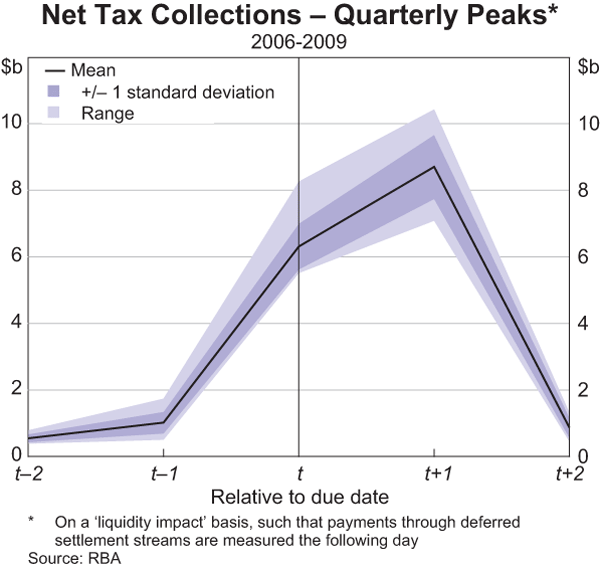
Reflecting this inherent uncertainty, exogenous transactions may differ from forecasts. For payments settled the next day (on a deferred net settlement basis), any such unexpected movements are observed prior to undertaking market operations the following morning and the amount of liquidity injected can be adjusted accordingly.[8] However, unexpected changes in payments settled the same day (on a real-time gross settlement basis) are observed only after morning market operations and so directly affect ES balances. For example, if same-day tax collections are stronger than forecast, additional liquidity is withdrawn leaving total ES balances lower than intended. The effects of same-day deviations from forecasts are asymmetric in that a level of ES balances that is too low is more likely to place pressure on the cash rate than a level that is too high. As such, on days when same-day flows are particularly uncertain, the Reserve Bank will look to increase ES balances to mitigate the risk of aggregate ES balances being too low. Nonetheless, if ES balances fall low enough that pressure may be placed on the cash rate, a second round of open market operations can be undertaken later in the day to inject additional ES balances. However, this has been quite rare – in 2009/10, a second round of market operations was undertaken on only two occasions, while the median difference between the forecast for the system cash position and the actual outcome was only around $40 million.
Overall, the arrangements by which the Reserve Bank implements monetary policy have proven effective over time. The Bank has been able to maintain an appropriate level of ES balances by identifying and accommodating swings in demand, while forecasting and counterbalancing exogenous changes in supply. This has ensured that the cash rate has remained at the Reserve Bank Board's target and supported the stability and functioning of the Australian financial system.
Appendix A
The source of movements in system cash can be derived formally from looking at the Reserve Bank's balance sheet – a stylised version of which is presented in Table A1. The Bank's main assets are gold and foreign exchange reserves and domestic securities (either held outright or under repurchase agreement). The main liabilities are currency notes, ES balances and client deposits and, as with any financial institution, the Bank has a capital base.
| Assets | Liabilities |
|---|---|
| Gold and foreign exchange (GFE) | Australian currency notes on issue (C) |
| Domestic securities (DOM) | Exchange Settlement balances (ES) |
| – Outright | Deposits of clients (DEP) |
| – Under repurchase agreement | Other liabilities (OL) |
| Other assets (OA) | Capital and Reserve Bank Reserve Fund (K) |
|
Source: RBA |
|
Starting with the identity that assets equal liabilities and focussing on ES balances yields the following identity:

It is convenient to consider this relationship in first differences:

This illustrates that movements in aggregate ES balances result from either domestic market operations or exogenous transactions. Market operations, as noted in the body of the article, primarily include transactions in domestic securities, particularly under repo. These are initiated by the Reserve Bank with the express intent of influencing the level of Australian dollar liquidity. Exogenous transactions include all other transactions, and relate to various assets and liabilities on the Reserve Bank balance sheet. In particular, these include:
- movements in client deposits, notably those of Australian Government departments and agencies;
- movements in foreign exchange reserves – note that only transactions in foreign exchange affect ES balances, as valuation gains and losses are balanced by an offsetting movement in the Reserve Bank's capital;[9] and
- changes in Australian currency notes on issue, due to the issuance or return of notes.
Footnotes
The authors are from Domestic Markets Department. [*]
In addition to ADIs, Exchange Settlement Accounts are held by several market infrastructure and special service providers. [1]
For additional information on market operations during the financial crisis see Debelle (2008a, 2008b). [2]
State, Territory and local governments do not bank with the Reserve Bank, and so their activities do not typically affect system liquidity. [3]
Large outlays are typically seen on the 7th and 21st of each month, or the next business day. [4]
Tax receipts peak around due dates on the 21st of each month, or the next business day, with particularly large peaks in the month after the end of each quarter. [5]
For further information on open market operations see <http://www.rba.gov.au/mkt-operations/>. The Australian repo market is discussed in Wakeling and Wilson (2010). [6]
To facilitate the operation of real-time gross settlement, institutions can also access ‘intraday’ liquidity. For further information on the Australian payments system see <http://www.rba.gov.au/payments-and-infrastructure/payments-system.html> and Gallagher, Gauntlett and Sunner (2010). [7]
As deferred net settlement transactions are settled at 9.00 am the following business day, they are known by the time market operations are announced at 9.30 am. [8]
On occasion, foreign exchange swaps are used to augment domestic market operations. [9]
References
Debelle G (2008a), ‘Market Operations in the Past Year’, Address to 2008 FTA Congress, Melbourne, 31 October.
Debelle G (2008b), ‘Open
Market Operations’, Address to Australian Debt Markets Conference
2008, Sydney,
27 June.
Gallagher P, J Gauntlett and D Sunner (2010), ‘Real-time Gross Settlement in Australia’, RBA Bulletin, September, pp 61–69.
Wakeling D and I Wilson (2010), ‘The
Repo Market in Australia’, RBA Bulletin, December, pp
27–35.